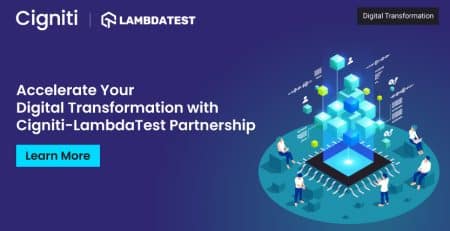Democratization of digital and evolution of CIOs in the new normal
|
Listen on the go!
|
Every company is a technology company today. Irrespective of the core product or service offering, each business is supposed to be digital and deliver seamlessly unified online experiences to the customers.
With the expeditious adoption of digital transformation all around the globe, digital technology is now more accessible than ever before. And the predictions for 2021 reveal only an upward trend in the adoption curve.
Given the surging expectations for digital customer experiences and deepening penetration of technology in our lives, each business has to fulfill the imminent need to democratize technology and it across its organization. Technology is no longer something that only the IT department has to deal with. Each function, vertical, and department now is relying on digital technologies for survival and growth.
Forrester predicts that the remote work scenario will rise by 300% in the next year. As organizations sail through this new wave of what the new normal looks like, they require strong digital capabilities on board. And to have those capabilities developed and implemented correctly, the ship has to be led by a strong CIO as the captain.
Martha Heller, CEO at Heller Search Associates and author of multiple books on IT leadership, talked in the latest edition of Cigniti’s QATalks podcast about the democratization of IT and the changing role of CIO. This blog is an excerpt from their discussion:
Immediate impacts of the pandemic on the role of CIOs
After the pandemic hit back in March, Martha spent about two months in a listening tour. The tour involved speaking to the CIOs from the leading Fortune 500 companies across a broad range of industries to understand how they are responding to the evolving situation. Talking about the takeaways from this activity, Martha said –
“For the first several months, it was all about getting the workforce to work remotely. Then there are security implications, disaster recovery, education, and rolling out collaboration technologies. The first phase of CIO priority, probably from mid-March to May, was just about getting these remote environments up and running. But then what quickly emerged were some additional areas. One is when companies all of a sudden, because of just a tremendous event that no one was anticipating, have to completely shift their distribution channels or markets. So the focus for CIOs became analytics. Do we have the analytics to understand our supply chain, to understand our markets, to be able to pivot? The watchword became pivot. We pivoted our workforce to a remote environment. That was the pivot number one.”
“Pivot number two was do we have the analytics to really change our business model, change our channels, change our markets, because the world is changing? And the third piece is digital. For a long time now, of course, CIOs have been accountable for workplace productivity, for analytics and for digital. I would say, that hasn’t changed, it’s just a catalyst, an accelerator to every one of those areas.”
As an advice or a word of caution to the CIO community, Martha recommends –
“It’s great that you got everybody remote, that was a huge feat of strength, very difficult to do and you should be very proud of yourself. But don’t regress. Don’t become a technical support office now because IT has moved past that long ago. It is all about revenue, analytics, digital, and the customer. So it’s great that you’ve got everybody into remote that was critically important to the company. But you’re not a remote services organization, you’re an innovation organization and a delivery organization. It’s time to move past being very proud of the remote work and now make sure we’re focused on analytics and digital.”
Software Quality Assurance becoming top priority for CIOs
While CIOs focus on enabling a remote workforce, leveraging analytics to change their organization’s business model, and accelerating digital agenda, they also need to remember the inevitable of software quality assurance in all this. As Martha says –
“Analytics, digital, and a remote workforce come with two major challenges for the CIOs. One is how do they ensure the cybersecurity, the testing of those environments in remote conditions without compromising security standards? Here comes in the quality assurance of those applications to make sure that cybersecurity and the application is well protected. The second is about automation. They want more of digital delivered to their end-customer much faster without any manual intervention. A lot of shift left that have happened in order for them to automate the upfront of the lifecycle. So they want the requirements being thoroughly tested, automated. And they want to see a lot of the digital to be deployed into multiple systems like it could be on multiple browsers, technologies, multiple platforms, multiple devices and that brings in the complexity of ensuring the product quality and the brand is protected. So, quality assurance becomes a top priority for CIOs in two areas. One is to make sure that automation is successful for them, and the second is about the cyber security or the security aspect of those applications.”
IT leaders leaning into the democratization of digital
As technology and digital becomes a business imperative and a process imperative, IT leaders cannot be solely responsible for the entire organization. Talking about this transition, Martha points out democratization of IT –
“It’s a shift from CIOs from being very operational, having huge teams, accountability for everything, to being more focused on architecture, governance, and some of the more guardrail-oriented responsibilities for IT, and that is a shift. But it’s within a broader shift. The CIOs will say, “As we become a technology company, I can have every single resource in the entire business reporting to me but that doesn’t make sense. I need to think through how do we dismantle those silos, how do we create teams where everybody feels that they’re connected in technology development in the business that’s really digital economy organizational design thinking. It does change the emphasis from empire building, big staff, and being accountable for activities that maybe you don’t have direct power over.” That’s a new way of thinking. And it’s a new skillset that CIOs are going to need to develop if they’re going to bring their companies into the height of this new data economy.”
QA as an integral part of software development
Irrespective of who has the accountability for what, every organization is looking at delivering its products to the customers through various channels, as quickly and as efficiently as possible. Noting the integral part of QA in ensuring this, Martha says –
“There are a lot of aspects to it. One, you’re bringing in automation to accelerate IT lifecycle and go to market. Second, consumer sentiment, as organizations are getting it from the direct source now such as social media channels, YouTube, and various other channels. They are taking that as an input and coming up with an artificial intelligence to make sure that their future product address to their consumer segments. Testing or quality assurance takes all those inputs and provide those use cases or test cases to make sure that the end user requirement is met.”
“The third is about performance – performance testing or performance engineering associated to it. In the past, you waited for a product to go live, you went to the store or you took a lot of time to do that. In today’s world, you want to get everything faster. So you want to make sure that performance and performance engineering is addressed. If you address it, you can handle the volume, you can handle the digital consumers that are getting the product much faster than what they used to be. And with holiday season coming into that, a lot of those digital consoles are getting prepared and a lot of retailers are looking at digital as their primary source of revenue. In this aspect, the CIOs are looking at scaling up their applications and making sure that the performance testing and the quality assurance of the performance is met as well.”
“And most important is the security aspect. CIOs want to make sure that their entire system including their infrastructure, network, applications, penetration, all of these are completely protected. That is the quality assurance priority for them. These are some of the areas that CIOs are mandating in their initiatives.”
To sum up
As an overall advice to the CIOs, Martha said, “for CIOs to be successful in this next economic period that we’re seem to be entering into, it’s going to be as close to the business, strategically, intellectually, and organizationally as you possibly can be, because this notion that IT is here and the business is there makes no sense. When IT is involved in every aspect of the business, why isn’t it the business?” So that’s the piece of advice. Through a variety of means, ensure that you are as embedded in what’s happening in your business as any other function.”
At Cigniti, we have an in-house pool of experts, vetted software quality professionals, and seasoned leaders who have helped several organizations across industries in their digital transformation initiatives. To learn how we can assist your organization navigate the digital journey, schedule a discussion with us.





Leave a Reply